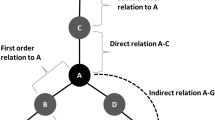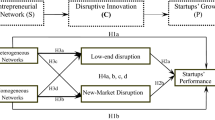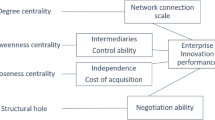Abstract
This study investigates how the alliance partners’ ego-network advantages, measured by the betweenness centrality, clustering coefficient and degree, affect focal firms’ ego-network advantages, innovation performance and the alliance stability. Under the exploitative innovation paradigm, alliance partners holding greater ego-network advantages would significantly improve focal firms’ ego-network advantages; Clustering coefficient and degree of alliance partners’ ego-network significantly improves focal firms’ innovation performance; However, they generate significant but mixing effect on the alliance stability. As innovation becomes more exploitation oriented, all of these effects weaken. Alliance partners’ ego-networks generate relatively weaker indirect effects on the focal firms as that of their own ego-networks. This suggests that the indirect network effects are not negligible. Our study suggests that alliance partners play a rather periphery role under exploratory innovation paradigm compared with that under the exploitative innovation paradigm. This is because the former requires more indigenous efforts to make breakthrough inventions. The results based on the counterfactual simulation process focus on the effect of key alliance partners’ ego-networks and reach generally similar conclusions, which confirms the robustness of this study. We discuss these findings and formulate policy implications at the end of this study.







Similar content being viewed by others
Notes
Alliance partners are limited to firms only in this study.
References
Ahuja, G., Soda, G., & Zaheer, A. (2012). The genesis and dynamics of organizational networks. Organization Science,23(2), 434–448.
Bahlmann, M. D. (2014). Geographic network diversity: How does it affect exploratory innovation? Industry and Innovation,21(7–8), 633–654.
Baum, J. A. C., Calabrese, T., & Silverman, B. S. (2000). Don’t go it alone: Alliance network composition and startups’ performance in Canadian biotechnology. Strategic Management Journal,21(3), 267–294.
Baum, J. A. C., Cowan, R., & Jonard, N. (2010). Network-independent alliance partner selection and the evolution of innovation networks. Management Science,56(11), 2094–2110.
Baum, J. A. C., Cowan, R., & Jonard, N. (2014). Does evidence of network effects on firm performance in pooled cross-section support prescriptions for network strategy? Strategic Management Journal,35, 652–667.
Cowan, R., & Jonard, N. (2009). Knowledge portfolios and the organization of innovation networks. Academy of Management Journal, 34(2), 320–342.
Cowan, R., Jonard, N., & Zimmermann, J. (2007). Bilateral collaboration and the emergence of innovation networks. Management Science,53(7), 1051–1067.
Das, S., Sen, P. K., & Sengupta, S. (1998). Impact of strategic alliances on firm valuation. Academy of Management Journal,41, 27–41.
Du, Y. Q., Song, B. J., Duan, H. B., Tsvetanov, T. G., & Wu, Y. Y. (2019). Multi-renewable management: Interactions between wind and solar within uncertain technological ecological system. Energy Conversion and Management,187, 232–247.
Duysters, G., & Lokshin, B. (2011). Determinants of alliance portfolio complexity and ties effect on innovative performance of companies. Journal of Product Innovation Management,28(4), 570–585.
Fleming, L., & Sorenson, O. (2001). Technology as a complex adaptive system: Evidence from patent data. Research Policy,30(7), 1019–1039.
Funk, R. J. (2014). Making the most of where you are: Geography, networks, and innovation in organizations. Academy of Management Journal,57(1), 193–222.
Gay, B., & Dousset, B. (2005). Innovation and network structural dynamics: Study of the alliance network of a major sector of the biotechnology industry. Research Policy,34, 1457–1475.
Gilsing, V., & Nooteboom, B. (2006). Exploration and exploitation in innovation systems: The case of pharmaceutical biotechnology. Research Policy,35, 1–23.
Gilsing, V. A., Nooteboomb, B., Vanhaverbekec, W., Duysters, G., & van den Oorda, A. (2008). Network embeddedness and the exploration of novel technologies: Technological distance, betweeness centrality and density. Research Policy,37(10), 1717–1731.
Gnyawali, D. R., & Madhavan, R. (2001). Cooperative networks and competitive dynamics: A structural embeddedness perspective. Academy of Management Review,26(3), 431–445.
Guan, J. C., & Liu, N. (2016). Exploitative and exploratory innovations in knowledge network and collaboration network: A patent analysis in the technological field of nano-energy. Research Policy,45, 97–112.
Gulati, R. (1995). Sociological structure and alliance formation patterns: A longitudinal analysis. Administrative Science Quarterly,40, 619–652.
Gulati, R. (1999). Network location and learning: The influence of network resources and firm capabilities on alliance formation. Strategic Management Journal, 20(5), 397–420.
Gulati, R., Sytch, M., & Tatarynowicz, A. (2012). The rise and fall of small worlds: Exploring the dynamics of social structure. Organization Science,23(2), 449–471.
Hofman, E., Halman, J. I. M., & Song, M. (2017). When to use loose or tight alliance networks for innovation? Empirical evidence. Journal of Product Innovation Management,34(1), 81–100.
Jacob, J., & Duysters, G. (2017). Alliance network configurations and the co-evolution of firms’ technology profiles: An analysis of the biopharmaceutical industry. Technological Forecasting and Social Change,120, 90–102.
Jiang, H., Xia, J., Cannella, A. A., & Xiao, T. (2018). Do ongoing networks block out new friends? Reconciling the embeddedness constraint dilemma on new alliance partner addition. Strategic Management Journal,39(1), 217–241.
Jiang, J., Tao, Q., & Santoro, M. (2010). Alliance portfolio diversity and corporate performance—The case of global automobile industry. Strategic Management Journal,31(10), 1136–1144.
Kang, R., & Zaheer, A. (2018). Determinants of alliance partner choice: Network distance, managerial incentives, and board monitoring. Strategic Management Journal,39(10), 2745–2769.
Karamanos, A. G. (2016). Effects of a firm’s and their alliance partners’ alliance ego-network structure on its innovation output in an era of ferment. R&D Management,46(S1), 261–276.
Kumar, P., & Zaheer, A. (2019). ego-network stability and innovation in alliances. Academy of Management Journal,62(3), 691–716.
Lacetera, N., Cockburn, I. M., & Henderson, R. (2004). Do firms change capabilities by hiring new people? A study of the adoption of science-based drug discovery. In J. A. C. Baum & A. McGahan (Eds.), Advances in strategic management (pp. 133–159). New York: Elsevier.
Laureiro-Martínez, D., Brusoni, S., Canessa, N., & Zollo, M. (2015). Understanding the exploration-exploitation dilemma: an fmri study of attention control and decision-making performance. Strategic Management Journal, 36(3), 319–338.
Lechner, C., Frankenberger, K., & Floyd, S. W. (2010). Task contingencies in the curvilinear relationships between intergroup networks and initiative performance. Academy of Management Journal,53(4), 865–889.
Levinthal, D. A., & March, J. G. (1993). The myopia of learning. Strategic Management Journal,14(S2), 95–112.
Lungeanu, A., & Contractor, N. S. (2015). The effects of diversity and network ties on innovations: The emergence of a new scientific field. American Behavioral Scientist,59(5), 548–564.
Macaulay, C. D., Richard, O. C., Peng, M. W., & Hasenhuttl, M. (2018). Alliance network centrality, board composition, and corporate social performance. Journal of Business Ethics,151(4), 997–1008.
March, J. G. (1991). Exploration and exploitation in organizational learning. Organization Science,2(1), 71–87.
Milliken, F. J., Bartel, C. A., & Kurtzberg, T. R. (2003). Diversity and creativity in work groups: A dynamic perspective on the affective and cognitive processes that link diversity and performance. In P. B. Paulus & B. A. Nijstad (Eds.), Group creativity: Innovation through collaboration (pp. 32–62). New York, NY: Oxford University Press.
Patel, P. C., Fernhaber, S. A., Mcdougall-Covin, P. P., & van Der Have, R. P. (2014). Beating competitors to international markets: The value of geographically balanced networks for innovation. Strategic Management Journal,35, 691–711.
Phelps, C. C. (2010). A longitudinal study of the influence of alliance network structure and composition on firm exploratory innovation. Academy of Management Journal,53(4), 890–913.
Rothaermel, F. T., & Deeds, D. L. (2004). Exploration and exploitation alliances in biotechnology: A system of new product development. Strategic Management Journal,25, 201–221.
Sá, C., & Lee, H. (2012). Science, business, and innovation: Understanding networks in technology-based incubators. R&D Management,42, 243–253.
Salman, N., & Saives, A. L. (2005). Indirect networks: An intangible resource for biotechnology innovation. R&D Management,35, 203–215.
Schilling, M. A., & Phelps, C. C. (2007). Interfirm collaboration networks: The impact of large-scale network structure on firm innovation. Management Science,53(7), 1113–1126.
Schreiner, M., Kale, P., & Corsten, D. (2009). What really is alliance management capability and how does it impact alliance outcomes and success? Strategic Management Journal,30, 1395–1419.
Sorenson, O., Rivkin, J. W., & Fleming, L. (2006). Complexity, networks and knowledge flow. Research Policy,35, 994–1017.
Stuart, T. E. (2000). Interorganizational alliances and the performance of firms: A study of growth and innovation rates in a high technology industry. Strategic Management Journal,21(8), 791–812.
Stuart, T., & Podolny, J. (1999). Positional causes and correlates of strategic alliances in the semiconductor industry. In S. Andrews & D. Knoke (Eds.), Research in the sociology of organizations (pp. 161–182). Greenwich, CT: JAI Press.
Sullivan, B. N., Haunschild, P., & Page, K. (2007). Organizations non-gratae? The impact of unethical corporate behavior on interorganizational networks. Organization Science,18(1), 55–70.
Taylor, A., & Greve, H. R. (2006). Superman or the fantastic four? Knowledge combination and experience in innovative teams. Academy of Management Journal,49, 723–740.
Todo, Y. (2003). Empirically consistent scale effects: An endogenous growth model with technology transfer to developing countries. Journal of Macroeconomics,25, 25–46.
Tortoriello, M., McEvily, B., & Krackhardt, D. (2015). Being a catalyst of innovation: The role of knowledge diversity and network closure. Organization Science,26(2), 423–438.
Tushman, M. L., & O'Reilly, C. A. (1996). Ambidextrous organizations: Managing evolutionary and revolutionary change. California Management Review, 38(4), 8–30.
Wang, C. L., Rodan, S., Fruin, M., & Xu, X. Y. (2014). Knowledge networks, collaboration networks, and exploratory innovation. Academy of Management Journal,57(2), 890–913.
Watts, J. K. M., & Koput, K. W. (2019). The downside of prominence in a network of marketing alliances. Journal of Business Research, 104, 196–205.
Williams, K. Y., & O’Reilly, C. A., III. (1998). Demography and diversity in organizations: A review of 40 years of research. Research in Organizational Behavior,20, 77–140.
Xia, J., Wang, Y. G., Lin, Y., Yang, H. B., & Li, S. L. (2018). Alliance formation in the midst of market and network: Insights from resource dependence and network perspectives. Journal of Management,44(5), 1899–1925.
Yamakawa, Y., Yang, H. B., & Lin, Z. (2011). Exploration versus exploitation in alliance portfolio: Performance implications of organizational, strategic, and environmental fit. Research Policy,40, 287–296.
Yang, H., Phelps, C., & Steensma, H. K. (2010). Learning from what others have learned from you: The effects of technology spillovers on the originating firms. Academy of Management Journal,53(2), 371–389.
Zhang, J. M., Jiang, H., Wu, R., & Li, J. Z. (2019). Reconciling the dilemma of knowledge sharing: A network pluralism framework of firms’ R&D alliance network and innovation performance. Journal of Management,45(7), 2635–2665.
Acknowledgements
This research was funded by [National Natural Science Foundation of China] grant number [71872169, 71874177, 71843002, 71810107004, 71772014], [Beijing Natural Science Foundation] grant number [9202019], [University of Chinese Academy of Sciences] grant number [Y8540XX1P2, Y8540XX1Z2], [National Social Science Foundation of China] grant number [18ZDA101], and [IBSS Development Fund].
Author information
Authors and Affiliations
Corresponding author
Rights and permissions
About this article
Cite this article
Zhang, G., Wang, X. & Duan, H. Obscure but important: examining the indirect effects of alliance networks in exploratory and exploitative innovation paradigms. Scientometrics 124, 1745–1764 (2020). https://doi.org/10.1007/s11192-020-03586-3
Received:
Published:
Issue Date:
DOI: https://doi.org/10.1007/s11192-020-03586-3




